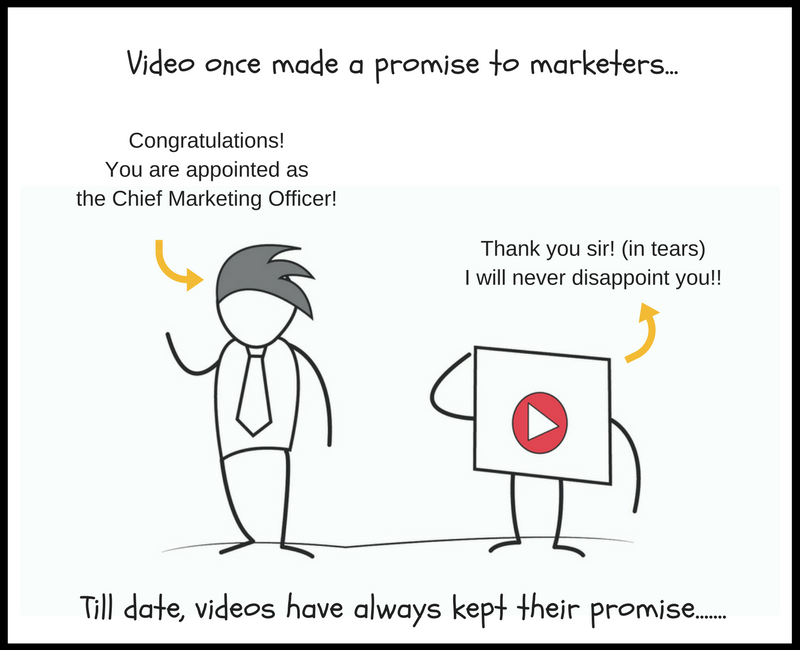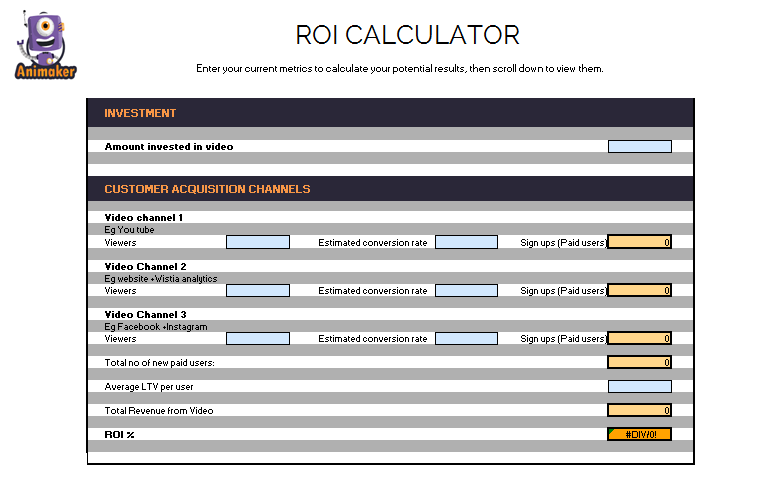How much should Content Marketers invest on videos? (Free personalised ROI calculator)!!
The subsequent years after 2010 saw an unprecedented rise in online video content. Over these years, even age-old businesses have slowly accepted online video as a part of their marketing strategy. Videos, in turn, have never disappointed them till date.
The case of ROI with video.
Though videos are positively affecting your sales, it seems difficult to measure the contribution of Videos in your business ROI. More than 44 percent of small and medium-sized businesses feel that measuring ROI is the biggest obstacle in video marketing.- 2015 B2B Video Content Marketing survey from Flimp Media and ReelSEO. Marketers find this difficulty in measuring ROI in the case of videos because there are many parameters (views, watch time, annotations, etc.), which are rarely quantifiable, and hence there is no direct approach to calculating the ROI. The lack of direct approach in measuring ROI has led to the failure in achieving business results. As a marketer, you need to have an estimate as to whether the investment you laid has converted into profitable revenue or not. Because if you cannot measure, you cannot move ahead with your business goals. Marketers who apprehended that video ROI is not measurable have got it all wrong. In fact, Video is the only type of content that has ‘players’ that determine the video's performance. No blog post has the feature or the ability to measure the points at which the attention of the viewers' drop. The video metrics are far ahead of the curve when it comes to parameters concerning the video and the viewer. And with these analytical data, you could make your next idea even better. The real problem that the marketers face is not with the lack of analytical data. It’s with linking the analytical data to the final Return on investment. Seeing that there aren't many tools that can determine the ROI of your marketing videos,we have put together a personalised solution for it - Animaker’s video ROI calculator. You just need to enter the analytics numbers in the boxes given and hit calculate. Your ROI will be returned to you in a jiffy. Before calculating your ROI, you need to know why measuring ROI is so inevitable for the success of businesses. Why do you need to measure your ROI? Peter Drucker says: “If you can’t measure it, you can’t manage it." Smart business owners must make sure that they see a positive return on investment (ROI) on their campaign costs. If you don’t, there’s a chance you’re wasting your budget. At the end of the day, the point of any marketing effort is to yield positive results for your brand, so being able to track growth will help you improve your marketing strategy and also in moving forward as a company. A survey by the Fournaise Marketing group shows that 71 percent of marketers failed in their business results because they did not track their metrics but focused more on experimenting on new areas of marketing. Measurement is the key analytic to your business strategy and if neglected can incur a huge loss.“A huge majority failed to track and attribute marketing spend to closed business. As budgets continue to increase, this tracking is critical to understanding whether your content strategy is effective. Without a means of evaluation (or by ignoring the data you have, which is even worse), you’re letting your gut dictate your content marketing decisions, instead of letting your audience's’ preferences determine your direction.”
- Michael Litt
So, if you want to win in your marketing efforts, you need to set a goal, play your part, track your metrics and improvise your approach.”
1. Set your goals
What action do you want your audience to take after watching the video? Every video you create needs to have an objective that drives your audience towards your business. Your business goals may vary from time to time. In fact, you’ll have to evaluate your goals for every campaign you launch. Examples are many: You could launch a campaign to drive sales for a new product launch or launch an informational campaign that educates and builds brand strength. Either way in any case, if you don’t know your goals, you can’t measure your success. In the case of videos, you must have an understanding as to what the possible goals a video can achieve. A video can- Increase brand awareness.
- Increase customer engagement
- Increase sales.
- Help achieve higher conversion rates
- Set a customer base and loyalty
- Likes, shares, comments and outreach on social media
- Higher Click-through rates
2. Keep an eye on the analytics.
Analytics tools help you get a detailed and thorough inspection of how your content is performing. With the help of Google Analytics and YouTube analytics, you could get almost all the possible metrics to analyse your content’s performance. Google analytics can give you access to the acquisition, behavioral aspects of your content like the number of visitors, the bounce rate, and the traffic sources which heads to your website. Whereas, YouTube analytics can help you dive deeper into your video performance. It can give you the hotspots where the audience decides to repeat your video or the drop spots where the audience retention factor is dropping. It can show you the watch rate and the number of hours your video has been viewed. YouTube analytics have a larger scope of research regarding your content. As for the Wistia analytics, it can give a bit more detailed information about the behavioral aspect of the audience watching the video. It tracks the viewer's movement online after watching the video- like are they heading towards the signup page or are they quitting the page.3. Measure your ROI (with our personalised ROI calculator)
After collecting the analytics, all that you have to do is enter those values in the boxes given and Hit calculate! We will calculate the ROI of marketing videos for you in a jiffy. Here is a screenshot of Animaker's ROI calculator. You can download it at the end of the blog article. Instructions to use the ROI calculator.
In case you are struggling to use Animaker ROI calculator, let me help you with it.
Instructions to use the ROI calculator.
In case you are struggling to use Animaker ROI calculator, let me help you with it.
- Step 1: You need to first start with keeping track of how much you invested in the video. You need to enter those values in the Investment section.
- Step 2: Every video channel has a native analytics tool. By accessing the analytics, you can measure the viewership and the performance of your videos online. Enter the number of viewers from each video channel in the respective boxes given.
- Step 3: You might have tracked your campaign before. So you have a fair idea on the conversion percentage of your videos. A good video always gets a good conversion. On an average, the typical conversion rates range from as low as 0.5 % to as high as 100%. Few companies have seen a 100% conversion rates during festive offers given by them to their customers. So the conversion rate of a video can always be estimated. Based on your idea, enter the values of the respective estimated conversion rate for every video channel.
- Step 4: Enter the LTV of your customer. Here is a link that explains about calculating the LTV of a customer in detail.
- Step 5: You are done with it! Your ROI in the case of videos is returned to you.
- How do I determine whether my marketing initiatives in videos are worth the time and money I invest in them?
- How much should I invest in videos?
- Do videos give a good ROI?
- And how should one measure ROI in the case of videos?






